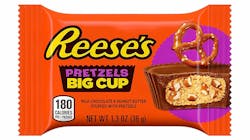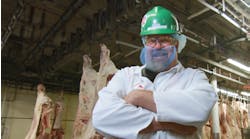That’s not easy. It’s even harder when the direction changes, as it has several times for the Hershey Co.
In the early 2010s, then-CEO J.P. Bilbrey pushed Hershey to grow international sales. That meant R&D had to do a lot of delving into things like how to make milk chocolate creamier for European tastes. Then Michele Buck became CEO in 2016 and decided to refocus Hershey’s growth away from overseas and more toward the North American market, where Hershey grew sales in part by acquiring salty-snack companies. Those acquisitions brought a whole set of new challenges, because they opened up opportunities for cross-branding and development of products that married sweet and salty flavors.
Hershey’s R&D is based in several locations. The main one is the Technical Center, a 250,000-sq.-ft. building near its headquarters in Hershey, Pa. that includes several pilot plants. Also in Hershey is the Global Customer Insights Center, opened in 2006 and refurbished several times, most lately in 2019. It’s where retailers get to try out interactive customer experiences and look at life-size examples of merchandizing for checkout stations and candy aisles.
Hershey also has an interest in a research facility in Charlottesville, Va., that’s dedicated to production of low-calorie alternative sugars. That facility is run by Bonumose Inc.; its construction was funded by Hershey in partnership with ASR Group, a sugar processor.
And while Buck may have de-emphasized the overseas market, Hershey opened a new R&D center in Malaysia in May that will serve as a central hub for innovations for products across the Asia-Pacific region. (Hershey also runs the Hershey Center for Applied Research in Hummelstown, Pa., which offers R&D third-party services to outside customers.)
Not just product innovation
When Buck took over Hershey, she set a different direction for R&D. As with many companies with iconic brands, Hershey had been basing its innovation on tweaking them with flavor variations. Buck reoriented this focus.
“In the U.S. confection business we had been leaning a bit too heavily on product innovation to drive growth,” Buck wrote in an article for the Harvard Business Review. “We needed to get more creative in other areas — such as marketing, packaging, and pricing — to increase demand for our long-standing core brands.” For instance, Hershey determined that stand-up pouches were the best way to merchandise certain SKUs of piece candy; it launched new standup packaging for 150 items in 2019.
One of the guiding principles for Hershey under Buck’s tenure was extending Hershey products into new eating occasions and for new consumers. It introduced Reese’s snack cakes in 2020 as a “midmorning treat,” and oat milk chocolate bars last year, its first foray into plant-based dairy alternatives.
These acquisitions mesh with the big Reese’s stuffed-cup revolution. It started with Reese’s cups being filled with Reese’s Pieces. Then in 2020, Hershey rolled out Reese’s Cups with pretzel pieces, then Big Cups stuffed with potato chips. The first Reese’s snack cakes were positioned for midmorning; the ones with savory fillings are intended more for later in the day, when research shows that consumers are more likely to want to feel full.
This kind of tinkering isn’t easy. Even something as seemingly simple as reducing the size of a Reese’s cup, which Hershey did when it introduced bite-sized cups in the early 2010s, took a lot of calculating by R&D. They had to account for the change in the chocolate-to-peanut-butter ratio inherent in the smaller size and reduce the viscosity of the peanut-flavored filling, because the formulation for the regular size cup didn’t flow fast enough into the molds for the smaller ones.
Hershey’s R&D operation has its hands full figuring out variations like this for many of its brands. There are many possibilities for flavor and other variations on Hershey’s full lineup of iconic products. The company rolled out some two dozen new products at this year’s Sweets & Snacks Expo, including: Kit Kat Strawberry Duos (with dark chocolate), Kit Kat THiNS Chocolate Hazelnut, two new Cadbury flavors (Black Forest Cake and Rock the Road), Rolo Dark Salted Caramel and more.
Consumer cues
To guide these variations, Hershey in the mid-2000s decided to ramp up its efforts to develop consumer insights. It contacted consumers directly, through surveys and focus groups, to try to understand better when and why they bought and consumed candy and other snacks.
That approach served them well during the pandemic. One example: In the early spring of 2020, when the pandemic was really starting to take hold, Hershey started noticing that sales of six-packs of its standard chocolate bars were spiking.
They knew that this was a key SKU for families who wanted to make s’mores – but s’mores season ordinarily didn’t start until months later. So Hershey did some digging and found that a lot of families were opting for backyard s’mores to break up the monotony of quarantine. They ramped up production of the six-packs and started including backyard s’mores in their marketing. The result, Riggs told the National Retail Federation, was “the biggest s’mores season we’ve ever had.”
Hershey’s data-driven approach also applies to its retail customers, as it works with them to get more detailed information about shopping habits. In fact, providing insights to retail customers is a major function of R&D, especially at the Global Customer Insights Center. The GCIC shows visiting retailers things like the various merchandising configurations that are available to them, for holiday displays, checkout-aisle racks and more.Hold the sugar
Better-for-you products are part of Hershey’s long-term plan. Recent better-for-you items include THiNS versions of Reese’s and Kit Kat, and zero-sugar versions of Hershey’s milk and dark chocolates and Reese’s cups. It also acquired Lily’s, a maker of low-sugar confections, last year.
The Bonumose deal was done by C7 Ventures, which is Hershey’s venture-capital arm. Like many food giants, Hershey finds it useful to occasionally buy innovation instead of forging it. Through C7, Hershey has acquired companies like Blue Stripes, a company that is pioneering the use of cacao pulp in a variety of foods, and Fulfil Holding Ltd., an Irish energy bar company (since sold to Ferrero).
Product development going forward at Hershey will incorporate one key element of the company’s long-term strategy: It’s no longer just a chocolate company.
As Buck put it in the Harvard Business Review: “We’re excited about what we make today and even more excited about the possibilities that lie ahead – for our customers, our retail partners and our people.”




